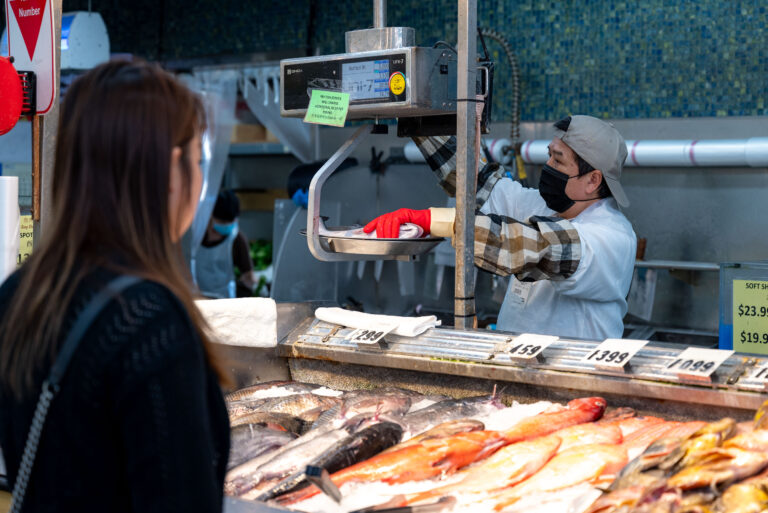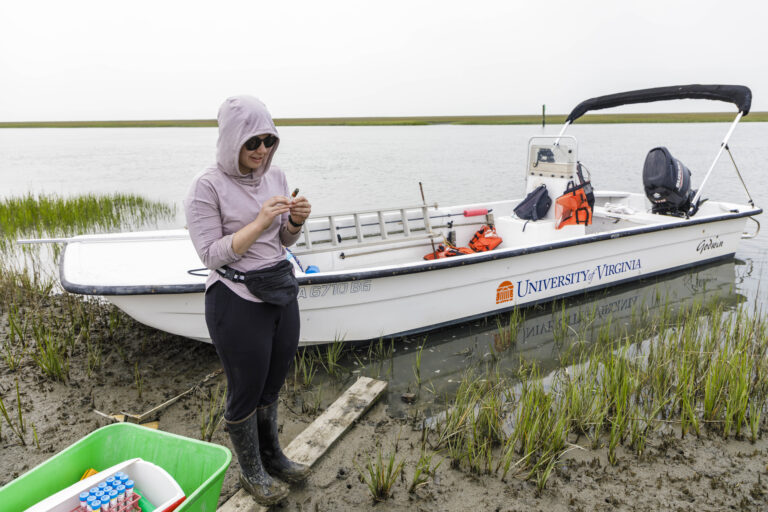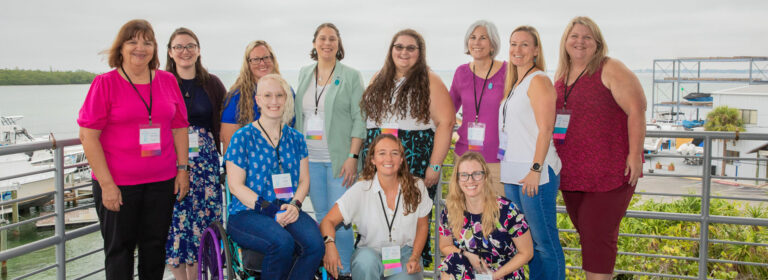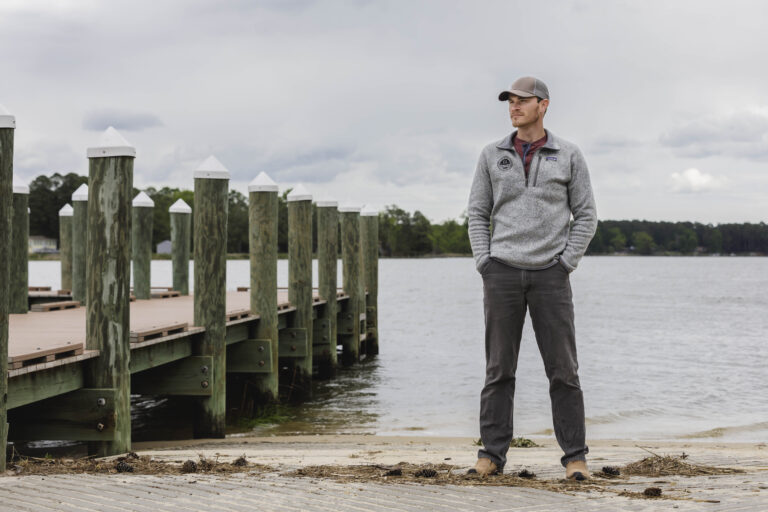Oysters at your doorstep: How the pandemic changed aquaculture sales
In April of 2020, the White Stone Oyster Company sent out 8,000 oysters to a wholesaler in Boston, who sells them to restaurants and other retailers, just like any other week. The next day, the wholesaler shipped those same oysters back to White Stone, unsold.
“Literally, wholesale stopped overnight,” said Allison Rutledge, the general manager at White Stone Oysters. “One day we were sending out as much as we’d ever sent out, and the next day, it literally just stopped. It was eerie.”
Their experience wasn’t an isolated event. For many oyster farmers, wholesale distributors are an essential link between individual companies who harvest seafood and the public, who consume the majority of their seafood in restaurants. In March and April of 2020, aquaculture growers reported that the vast majority of their sales to processors, restaurants, and distributors were drastically reduced or cancelled entirely, according to a survey from the Virginia Tech Seafood Agricultural Research and Extension Center.
In the next two months, for White Stone Oysters and many other seafood companies, business was mostly at a standstill. Even so, the company’s president, Tom Perry, noticed one small portion of their business actually started to grow: online sales. Through White Stone’s website, customers were purchasing oysters to be shipped directly to their homes.
Over the next year and a half, White Stone’s online sales grew steadily, at first, spontaneously — people noticed the company’s social media posts and found their website. Then, as the year went on, the company deliberately began making their website more user-friendly for customers and placing advertisements to boost sales.
By the end of 2020, consumer demand for delivery and takeout seafood increased by 270 percent, while restaurant demand for seafood dropped by as much as 70 percent, according to one study.
Shelling out
Selling direct to the public was a major shift for most aquaculture operations during the pandemic. In 2018, only about 4 percent of shellfish like oysters were sold directly to the public, according to information from the U.S. Department of Agriculture. During April, May, and June of 2020, almost half of aquaculture businesses reported trying a new marketing channel, according to the Virginia Tech survey.
By the end of 2020, consumer demand for delivery and takeout seafood increased by 270 percent, while restaurant demand for seafood dropped by as much as 70 percent, according to another study.
Of the different marketing options in the — home delivery, curbside, opening a retail outlet, online sales, or something else — about 70 percent of the businesses surveyed reported trying online sales.
“People needed to find new avenues, and going direct to consumer is certainly one of them. The state was there to help, if you were willing to take it,” Perry said.
Shipping Shell
Direct sales helped offset the decrease in wholesale, but also posed a new set of challenges for shipping logistics and customer interaction — new issues for a business used to selling their oysters in bulk to wholesalers.
“Wholesale, we’ll get an email from one account, a distributor in D.C. who wants 5,000 oysters for the day,” Perry said. “He’ll send one email, and we’ll send 50 bags. We put those bags in five or six boxes, and that’s it. Then you kind of forget about it. Maybe once or twice a year, there’s some sort of shipping issue. When we’re doing direct-to-consumer, we’re sending out packages to everyone, and everybody wants to have some sort of relationship with us.”
For starters, that involved answering customers’ questions and dealing with shipping difficulties. Rather than the handful of identical boxes required for a wholesale order, employees must pack online orders individually. This means more boxes, more gel packs and insulation, and more attention to extra items like shucking knives or containers of hot sauce in different orders. Now, White Stone has a dedicated room just for preparing online orders — an outlet they plan to continue, even as wholesale accounts recover.
Typically, a group might order White Stone oysters at a restaurant to mark a special occasion, but the company wouldn’t hear about their experience because those oysters came to the restaurant through a wholesaler. Direct sales gave them an opportunity to hear firsthand feedback from their customers.
“In their orders, people would write gift messages, a lot of birthdays, anniversaries, special gifts… That was cool to see,” Rutledge said.
Gradually, she said, the company saw first-time customers returning for more oysters when friends were in town, or shipping oysters long-distance as a gift for friends or family. Now, their fastest-growing demographic for sales is 25- to 35-year-olds.
“It’s a unique gift — you’re not sending your dad a tie,” Perry added.
“When we’re doing direct-to-consumer, we’re sending out packages to everyone, and everybody wants to have some sort of relationship with us,” Perry said.
The Aqua Farmers Market
Some oyster farmers, like Tommy Leggett of York River Oysters, turned to an audience already looking to purchase home-grown goods from local small business — the shoppers at farmers markets.
Part of Leggett’s customer base now includes patrons from the Toano Open Air Market. The local farmer’s market initially started in 2020, when its founder Maureen Anderson needed a new way to reach customers with her homemade soaps during the onset of the pandemic.
“We put little signs up on the road, and it was very much a yard-sale type situation,” Anderson said. “Tommy would pull in and park his truck. It just became more and more well-known, then more vendors heard and wanted to participate. At that time, everyone was really looking for a way to sell their goods, because all the other avenues were closed.”
Initially, the market began with Anderson, her daughter, and an herbal tincture maker. Now, the weekly event is held in a nearby field and includes nearly a dozen vendors each week, live music, food trucks, and occasional pony rides — an experience Anderson likens to a “slice of small town,” where shoppers can get to know the business owners. One week, the Virginia Bread Company and Leggett teamed up to give an oyster frying demo for market patrons.
Although other farmers markets Anderson participated in have included seafood, Anderson said Leggett’s contribution as a waterman and the fresh seafood he sells give the market a unique charm.
“It doesn’t come here frozen,” Anderson said. “To have fresh-harvested clams or oysters from within 35 minutes from here — that’s a rare find.”
Selling an Experience
When Leggett first started selling oysters years ago, there wasn’t much interest for direct sales, compared to other types of shellfish like clams or scallops. Although he’s seen more interest from direct customers in recent years, many people still don’t know how to shuck an oyster.
When Leggett sells a bag of oysters, there’s usually an element of education, he said. People don’t always know what to do with an oyster still in the shell. Although the entire seafood industry felt the effects of restaurant closures, oyster growers faced a particular challenge: compared to fish or clams, which are easier to prepare at home, few people know how to shuck an oyster in the shell.
“You might have to explain that there are other ways of dealing with it without shucking, like lightly cooking the oyster to open, or freezing it, or steaming or grilling,” Leggett said, adding that he also emphasizes the need to keep oysters cool during transport.
“To have fresh-harvested clams or oysters from within 35 minutes from here — that’s a rare find.”
Resources on the half shell
Oyster farmers already work closely with the Virginia Department of Health Shellfish Sanitation Division, and have a plan to keep oysters iced and cool. But shipping the oysters to customers or coordinating pickup is more complicated than simply loading oysters in bulk onto cold truck. To assist oyster growers with these new logistics, Virginia Sea Grant extension compiled resources about starting up direct sales, permitting requirements, and food safety at new venues like festivals or farmers markets.
Other organizations, like the Chesapeake Bay Foundation, started offering pop-up events where people could connect with local growers like Leggett to buy oysters. The Get Aquacultured Program, a VASG-sponsored partnership between local marketing agency Consociate Media and the Virginia Institute of Marine Science Marine Advisory Program, launched a series of food events themed around aquacultured oysters like Leggett’s. These events, including oyster-themed trivia nights, food trucks serving oysters at local breweries, and online virtual oyster and wine tastings, encouraged communities to try oysters at home.
In addition to selling oysters at the Toano Open Air Market, Leggett also redesigned his York River Oysters website in order to attract more online sales since the start of the pandemic. While he’s not looking to expand his business, Leggett said his updated website has brought him more and more customers.
“It’s not overwhelming, and I’m sure I could do more if I wanted to, but I’m not trying to expand,” Leggett said. “But if I was doing this 30 years ago, I’d be all over it.”
Photos and video by Aileen Devlin | Virginia Sea Grant
Story by Madeleine Jepsen | Virginia Sea Grant
Published December 3, 2021.
These events, including oyster-themed trivia nights, food trucks serving oysters at local breweries, and online virtual oyster and wine tastings, encouraged communities to try oysters at home.






